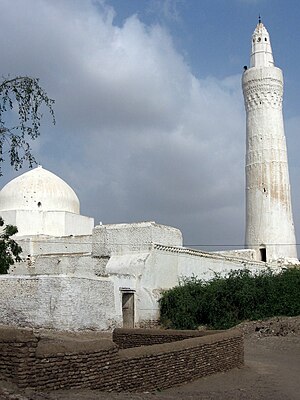Zabid
Zabīd | |
|---|---|
 | |
| Country | |
| Governorate | Al Hudaydah Governorate |
| Time zone | UTC+3 (Yemen Standard Time) |
| Official name | Historic Town of Zabid |
| Type | Cultural |
| Criteria | ii, iv, vi |
| Designated | 1993 (17th session) |
| Reference no. | 611 |
| State Party | |
| Region | Arab States |
| Endangered | 2000–present |
Zabid (Template:Lang-ar) (also spelled Zebid) is a town with an urban population of around 52,590 persons[1] on Yemen's western coastal plain. The town, named after Wadi Zabid, the wadi (or valley) to its south, is one of the oldest towns in Yemen. It was the capital of Yemen from the 13th to the 15th century and a center of the Arab and Muslim world due in large part to its famed University of Zabid and being a center of Islamic education. It was the capital of the Ziyadid dynasty from 819–1018 and the Najahid dynasty from 1022–1158.[2] Today, however, it is at the intellectual and economic margins of modern Yemen.[3]
Zabid has been declared a World Heritage Site by the UNESCO. Its Great Mosque occupies a prominent place in the town. The vestiges of its university can also be visited.
Threats to Zabid

In 2000, Zabid was listed on the List of World Heritage in Danger; the listing was made on the behest of the Yemeni government due to a state of poor upkeep and conservation. According to a UNESCO report, roughly "40% of the city's houses have been replaced by concrete buildings, and other houses and the ancient souk are in a deteriorating state.[4] If the city has not begun preservation of its cultural heritage within two years of its inscription as a UNESCO World Heritage Site, it faces possible loss of this vaunted status.[5]
Economy
As of 1920, Zabīd was one of two places in Arabia growing indigo. Zabīd also grows and produces cotton.[6] The British cite tribal disputes as dampening the economy in Zabīd during the early 20th century.[7]
See Also
References
- ^ population of Zabid
- ^ "Najahid Dynasty." Encyclopædia Britannica Online, 14 April 2006.
- ^ Eickelman, Dale F. "The Middle East and Central Asia." (Prentice Hall, Upper Saddle River: 2002)
- ^ UNESCO World Heritage Site in Danger 2000: Historic Town of Zabid
- ^ Ahmad al-Aghbari and Mohammad al-Ulofi (February 15, 2009). "Is Yemen Able to Keep Zabid Listed in World Heritage?". Saba News.
- ^ Prothero, G.W. (1920). Arabia. London: H.M. Stationery Office. p. 85.
- ^ Prothero, G.W. (1920). Arabia. London: H.M. Stationery Office. p. 103.
